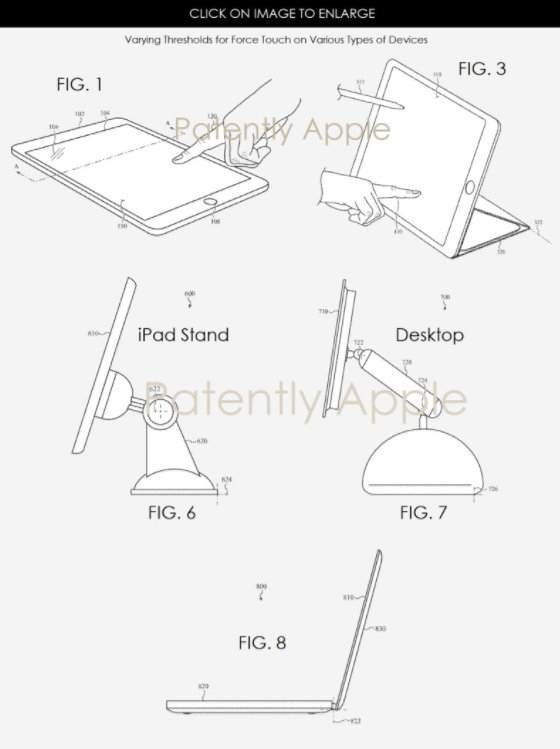 2427
2427
 2017-09-04
2017-09-04
On Thursday the US Patent & Trademark Office published a patent application from Apple that relates to electronic devices that use a dynamic or variable threshold to detect a force input. Today Apple's Force Touch used on iDevices is generally stable because it's being held by a user or it's resting on a stable surface. The same is true for Force Touch on a MacBook touch pad because the force is being directed downward on a stable table or surface. In this current patent filing Apple's engineers have reinvented Force Touch for devices that can be affected by too hard a push on the display.
Apple's engineers envision Force Touch being applied to a future MacBook display and therefore must readjust the threshold of force touch in such a scenario so as to avoid toppling the MacBook.
In another scenario, Apple engineers envision a future stationary magnetic-based iPad stand that would simply slide backwards on a desk or table if used with the current form of Force Touch. So once again, the thresholds have to be reset to keep the stand stable when using Force Touch. The same is true for a future desktop using a touch display. More specifically, Apple notes in their summary that their invention generally relates to an electronic device having a touch-sensitive surface or region that is configured to receive force-based user input. In particular, the device may include one or more force sensors that are configured to detect a touch that exceeds a predetermined force threshold.

The device may be configured to initiate or generate a press-event signal in response to a touch that exceeds the force threshold, which may be interpreted as user input by the device or operating system.
In some embodiments, the force threshold is dynamically adjusted in response to a detected or estimated stability condition in order to prevent tipping or undesirable movement of the device. By dynamically adjusting the threshold, touch user input for the device may be optimized for use with a particular mounting accessory or support configuration. In some cases, multiple sub-regions may be defined over the touch-sensitive surface, each sub-region having a different force threshold.
Apple further notes that a stability condition of the electronic device may be determined using one or more sensors (e.g., internal sensors). The force threshold may be reduced or modified for at least a portion of the touch-sensitive surface based on the stability condition.
A press-event signal may be initiated or generated in response to receiving a touch on the touch-sensitive surface that exceeds the force threshold. In some embodiments, a change in the stability condition of the electronic device is detected and, in response, an updated force threshold is set for the portion of the touch-sensitive surface. The updated force threshold may be based on the detected change in the stability condition.
Source: patentlyaple